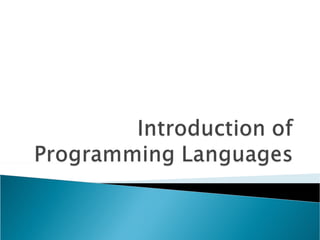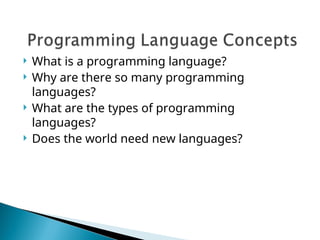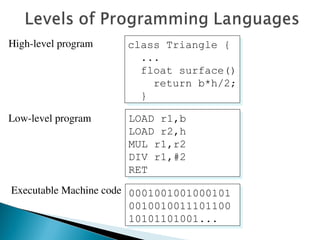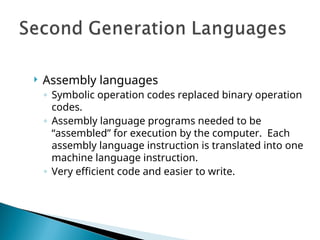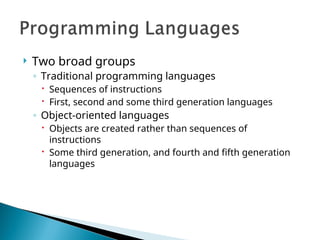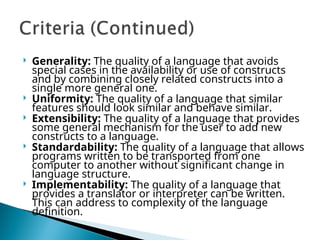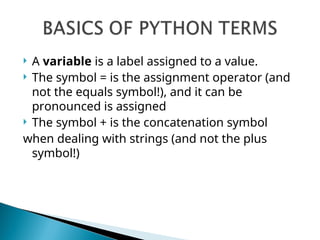Ad
lect1-introductiontoprogramminglanguages-130130013038-phpapp02.ppt
- 2. What is a programming language? Why are there so many programming languages? What are the types of programming languages? Does the world need new languages?
- 3. A programming language is a set of rules that provides a way of telling a computer what operations to perform. A programming language is a set of rules for communicating an algorithm It provides a linguistic framework for describing computations
- 4. PS — Introduction A programming language is a notational system for describing computation in a machine-readable and human-readable form. A programming language is a tool for developing executable models for a class of problem domains.
- 5. English is a natural language. It has words, symbols and grammatical rules. A programming language also has words, symbols and rules of grammar. The grammatical rules are called syntax. Each programming language has a different set of syntax rules.
- 6. Why does some people speak French? Programming languages have evolved over time as better ways have been developed to design them. ◦ First programming languages were developed in the 1950s ◦ Since then thousands of languages have been developed Different programming languages are designed for different types of programs.
- 7. High-level program class Triangle { ... float surface() return b*h/2; } Low-level program LOAD r1,b LOAD r2,h MUL r1,r2 DIV r1,#2 RET Executable Machine code 0001001001000101 0010010011101100 10101101001...
- 8. First Generation Languages Second Generation Languages Third Generation Languages Fourth Generation Languages Fifth Generation Languages
- 9. Machine language ◦ Operation code – such as addition or subtraction. ◦ Operands – that identify the data to be processed. ◦ Machine language is machine dependent as it is the only language the computer can understand. ◦ Very efficient code but very difficult to write.
- 10. Assembly languages ◦ Symbolic operation codes replaced binary operation codes. ◦ Assembly language programs needed to be “assembled” for execution by the computer. Each assembly language instruction is translated into one machine language instruction. ◦ Very efficient code and easier to write.
- 11. Closer to English but included simple mathematical notation. ◦ Programs written in source code which must be translated into machine language programs called object code. ◦ The translation of source code to object code is accomplished by a machine language system program called a compiler.
- 12. Alternative to compilation is interpretation which is accomplished by a system program called an interpreter. Common third generation languages ◦ FORTRAN ◦ COBOL ◦ C and C++ ◦ Visual Basic
- 13. A high level language (4GL) that requires fewer instructions to accomplish a task than a third generation language. Used with databases ◦ Query languages ◦ Report generators ◦ Forms designers ◦ Application generators
- 14. Declarative languages Functional(?): Lisp, Scheme, SML ◦ Also called applicative ◦ Everything is a function Logic: Prolog ◦ Based on mathematical logic ◦ Rule- or Constraint-based
- 15. Though no clear definition at present, natural language programs generally can be interpreted and executed by the computer with no other action by the user than stating their question. Limited capabilities at present.
- 16. Imperative Programming (C) Object-Oriented Programming (C++) Logic/Declarative Programming (Prolog) Functional/Applicative Programming (Lisp)
- 17. Two broad groups ◦ Traditional programming languages Sequences of instructions First, second and some third generation languages ◦ Object-oriented languages Objects are created rather than sequences of instructions Some third generation, and fourth and fifth generation languages
- 18. Simula ◦ First object-oriented language ◦ Developed by Ole Johan Dahl in the 1960s. Smalltalk ◦ First purely object-oriented language. ◦ Developed by Xerox in mid-1970s. ◦ Still in use on some computers.
- 19. C++ ◦ It is C language with additional features. ◦ Widely used for developing system and application software. ◦ Graphical user interfaces can be developed easily with visual programming tools.
- 20. Scripting Languages ◦ JavaScript and VBScript ◦ Php and ASP ◦ Perl and Python Command Languages ◦ sh, csh, bash Text processing Languages ◦ LaTex, PostScript
- 21. HTML ◦ HyperText Markup Language. ◦ Used on the Internet and the World Wide Web (WWW). ◦ Web page developer puts brief codes called tags in the page to indicate how the page should be formatted.
- 22. Programming languages are languages When it comes to mechanics of the task, learning to speak and use a programming language is in many ways like learning to speak a human language In both kind of languages you have to learn new vocabulary, syntax and semantics (new words, sentence structure and meaning) And both kind of language require considerable practice to make perfect.
- 23. Computer languages lack ambiguity and vagueness In English sentences such as I saw the man with a telescope (Who had the telescope?) or Take a pinch of salt (How much is a pinch?) In a programming language a sentence either means one thing or it means nothing
- 24. Formerly: Run-time performance ◦ (Computers were more expensive than programmers) Now: Life cycle (human) cost is more important ◦ Ease of designing, coding ◦ Debugging ◦ Maintenance ◦ Reusability FADS
- 25. Writability: The quality of a language that enables a programmer to use it to express a computation clearly, correctly, concisely, and quickly. Readability: The quality of a language that enables a programmer to understand and comprehend the nature of a computation easily and accurately. Orthogonality: The quality of a language that features provided have as few restrictions as possible and be combinable in any meaningful way. Reliability: The quality of a language that assures a program will not behave in unexpected or disastrous ways during execution. Maintainability: The quality of a language that eases errors can be found and corrected and new features added.
- 26. Generality: The quality of a language that avoids special cases in the availability or use of constructs and by combining closely related constructs into a single more general one. Uniformity: The quality of a language that similar features should look similar and behave similar. Extensibility: The quality of a language that provides some general mechanism for the user to add new constructs to a language. Standardability: The quality of a language that allows programs written to be transported from one computer to another without significant change in language structure. Implementability: The quality of a language that provides a translator or interpreter can be written. This can address to complexity of the language definition.
- 27. A variable is a label assigned to a value. The symbol = is the assignment operator (and not the equals symbol!), and it can be pronounced is assigned The symbol + is the concatenation symbol when dealing with strings (and not the plus symbol!)
- 28. •Variable: A named storage location in memory that holds a value. •Syntax: The set of rules that defines the combinations of symbols that are considered valid in the programming language. •Operator: A symbol that performs a specific operation on one or more operands (e.g., +, -, *, /). •Operand: A value or variable that an operator acts upon. •Function: A reusable block of code that performs a specific task. •Data Type: A classification that specifies the type of data (e.g., integer, float, string, list). •Conditional Statement: A statement that executes different code blocks based on whether a condition is true or false.
- 29. At the gym. You are the manager of a gym and you have to register a new person. What variables would you create? Write three variables, assign a value to each of them (make sure they are strings!), and print them out.
- 30. Question: Write a Python program that takes two numbers as input from the user and calculates their sum. 1. Prompt the user to enter the first number. 2. Prompt the user to enter the second number. 3. Calculate the sum of the two numbers. 4. Print the result in a formatted message.
